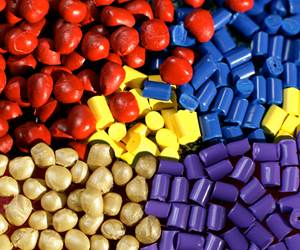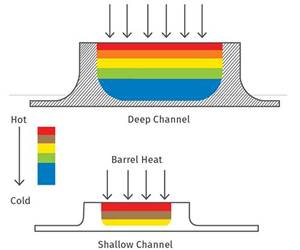How to Spec a Flat Die
So it’s time for you to buy a new die for film or sheet.
So it’s time for you to buy a new die for film or sheet. What do you need to know to about current die design technology to make sure you get what you need and want from your supplier?
The purpose of a flat die, of course, is to deliver a uniform flow of polymer across the exit of the die lip so that the film or sheet product is flat and the gauge is uniform. Because the die is “just a nozzle”—it simply takes what comes in and shapes and discharges it—it’s designed to “leak” uniformly. The ability of a die to deliver a uniform flow rate across the die lips is based on the internal shape and structure of the die. In so-called coat hanger dies, the shape of the triangular dam between the manifold and the exit, and the change in manifold diameter, determine the uniformity of flow. Alternatively, in an inverted preland die, the shape of the preland step determines the uniformity of flow across the die face.
How are those preland shapes determined? In the design calculations for all types of manifold dies, the internal shape of the flow dam is controlled by the slope of the curve of viscosity vs. shear rate. The slope of this curve is the power law index (n). As shown in the accompanying chart, n can vary considerably between resins.
Assuming you have a die good design for your polymer, you must supply it with a uniform melt quality to get the best results. This means a melt of a uniform temperature and pressure. Any variation of melt temperature and pressure entering the die will be passed through the die with little to no damping. So melt quality is job one for the processor.
Assuming that you have done your part with melt quality, what do you need to know about the die? First, it has to be kept at a uniform temperature. All dies are designed on the premise of isothermal flow. This means that the die heating should be sufficient to heat and maintain the die at constant temperature across the face of the die—and the die should probably be insulated, too.
Heating zones should be established across the face of the die, and a best practice is to have separate heating zones on both the “front” or adjustable lip side, and the “back” unadjustable lip side. Because the die ends can lose heat faster than the center, the heater power in the end zones is often higher than the center zones.
Dies are made with adjustable lips to help overcome the inevitable variations in flow across the die width due to melt-temperature variations and machining limitations inherent to all dies. Lip adjustment allows variation in lip opening to change the pressure drop and shear rate in that section of the die, providing a variable choke to modify flow rate at the die exit. If the film is too thin, you open the lip, and if too thick, you close the lip. There are many types of die bolts you could consider: manual push only, manual push-pull bolts, and heated/cooled bolts (push only or push-pull), which are used with automatic thickness adjusting systems.
Another thing to consider in a die purchase is the coating or plating of the internal flow surfaces. The steel die body is generally plated to improve die cleanliness and flow. Commonly used coatings are electroless nickel and chrome. There are also modified platings that can contain fluoropolymers, as well as die coatings that modify the plating surface. The best type of coating for your die will be determined by the resins and additives you will use.
Thus, specifying a die starts with getting viscosity data for the polymers you will use. Then make sure your extrusion system can ensure uniform melt temperature and pressure entering the die. Then choose a die design (coat hanger, inverted preland, etc.) best for your product. Ensure the heating capacity is sufficient and well thought out, and that the die is insulated. Also consider the method of die-lip adjustment and the die plating or coating.
About the Author
Dr. Eldridge M. Mount III has worked for the last decade as an independent consultant in coextrusion, extrusion, metallization, and converting. Before that he spent more than 30 years in extrusion and orientation of PP and PET films for ExxonMobil Chemical and ICI Americas. Email emmount@earthlink.net or visit emmount-technologies.com.
Related Content
Three Key Decisions for an Optimal Ejection System
When determining the best ejection option for a tool, molders must consider the ejector’s surface area, location and style.
Read MoreFundamentals of Polyethylene – Part 6: PE Performance
Don’t assume you know everything there is to know about PE because it’s been around so long. Here is yet another example of how the performance of PE is influenced by molecular weight and density.
Read MoreWhat You Need to Know About Leader Pins and Bushings
There’s a lot more to these humble but essential mold components than you might suspect. Following the author’s tips could save much time, money and frustration.
Read MoreThe Importance of Barrel Heat and Melt Temperature
Barrel temperature may impact melting in the case of very small extruders running very slowly. Otherwise, melting is mainly the result of shear heating of the polymer.
Read MoreRead Next
People 4.0 – How to Get Buy-In from Your Staff for Industry 4.0 Systems
Implementing a production monitoring system as the foundation of a ‘smart factory’ is about integrating people with new technology as much as it is about integrating machines and computers. Here are tips from a company that has gone through the process.
Read MoreSee Recyclers Close the Loop on Trade Show Production Scrap at NPE2024
A collaboration between show organizer PLASTICS, recycler CPR and size reduction experts WEIMA and Conair recovered and recycled all production scrap at NPE2024.
Read More











